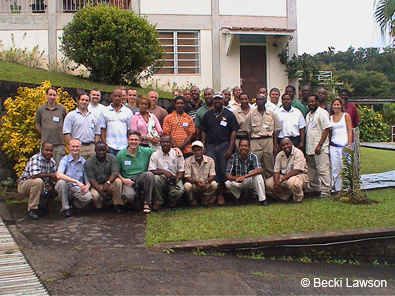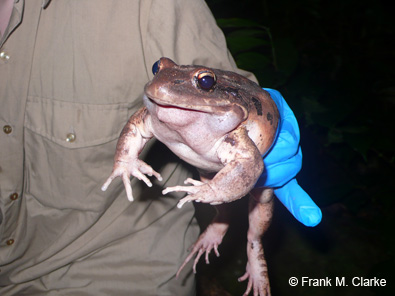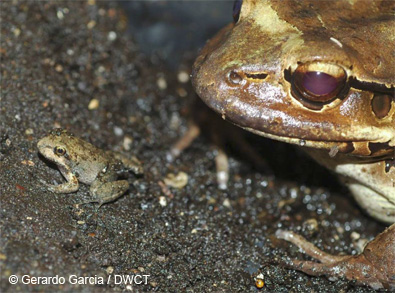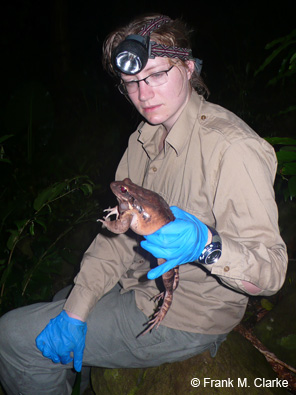EDGE Amphibians coordinator Helen Meredith recently attended a workshop on the conservation of Caribbean amphibians, and wrote this report about her experiences:
The Holy Redeemer is a religious retreat that stands on a heavily-forested volcanic slope in Dominica, where it is drenched by torrential downpours and looks out on the Caribbean Sea. At the beginning of April 2008 this peaceful site provided the location for a regional training workshop entitled “Prevention of Chytrid Spread and Early Surveillance Measures”. Funded by Defra’s Darwin Initiative and organised by the Institute of Zoology’s Dr. Andrew Cunningham and Becki Lawson, the workshop represented the culmination of a three year conservation project “Addressing a threat to Caribbean amphibians: capacity building in Dominica”.
Amongst the graphic depictions of the Crucifixion and life-size statues of the Virgin Mary, representatives from across the Lesser Antilles, the Dominican Forestry and Wildlife Division, the Zoological Society of London, Chester Zoo, the Durrell Wildlife Conservation Trust and Fauna and Flora International gathered in the name of Caribbean amphibian conservation. The guest list read like a top 10 of the Caribbean’s most idyllic holiday destinations, with representatives from St. Lucia, St. Kitts & Nevis, Barbados, Guadeloupe, Montserrat, Martinique, the U.S. Virgin Isles, Trinidad & Tobago, St. Vincent & the Grenadines and Puerto Rico. All were present to discuss the sinister spectre of disease which hangs over the region’s unique amphibian biodiversity.
Often referred to as chytrid, chytridiomycosis is caused by the fungal pathogen Batrachochytrium dendrobatidis and has triggered mass amphibian die-offs in many parts of the world. The disease was found to have reached the small island of Dominica in 2002 and has since resulted in the death of over 80% of the island’s population of mountain chicken frogs (Leptodactylus fallax). The mountain chicken (known locally as the “crapaud”) is one of the world’s largest frogs, reaching a total length (snout to vent) of nearly 17 cm. The males can be heard calling loudly for mates during the wet season and mating occurs terrestrially, with females caring for their young by feeding the tadpoles on unfertilised eggs in their damp underground burrows.
The mountain chicken is ranked =158 on the EDGE Amphibians list, which makes it a high priority EDGE species for conservation attention. They take their name from their chicken-like taste, which once contributed to a popular soup which is Dominica’s national dish, but is now off the menu.
Whilst many amphibians globally are suffering unpublicised extinctions, the mountain chicken has an unusually prominent status for a frog – it is present on Dominica’s coat of arms, is the logo for the National Bank of Dominica, features as the emblem of numerous other institutions, and even turns up in a local saying or two, for example “Kwapo pa ka vanté soup-yo” which is from the Kwéyòl meaning “Crapaud don’t fan their own soup”.
When dead mountain chickens started to be found in great numbers after 2002, it caused widespread national alarm. The Dominican Forestry and Wildlife Division were therefore highly motivated to join forces with ZSL to monitor the indigenous amphibian populations and chytrid outbreak across the island.
The primary goal of the three-day workshop was to seek a lasting resolve across the Lesser Antilles to prevent the spread of amphibian chytrid and possible extinction of the region’s numerous frog species. This has led to the development of a management plan entitled: “Chytridiomycosis Management Plan for the Lesser Antilles Region: Minimising the Risk of Spread, and Mitigating the Effects, of Amphibian Chytridiomycosis”.
A major outcome of the workshop was the generation of ideas to prevent the movement of chytrid between the islands of the Lesser Antilles – including immersing consignments of fruit from other islands in sea water to kill any stowaway amphibians which may be infected by chytrid. Representatives were encouraged to establish national amphibian and chytrid monitoring programmes on their islands and to raise awareness of the need for amphibian conservation.
Future plans for Dominica include the opening of the now partially-built mountain chicken conservation breeding centre, the erection of an awareness-raising monument of the frog and a possible “Croaking Crapaud” week as part of the 2008 Year of the Frog campaign to celebrate the conservation of Dominica’s most threatened and well-loved amphibian species.
As Dr. Andrew Cunningham commented during his televised address at the commencement of the workshop “I have never before participated in a conservation project that’s primary aim is to enable the target species to be eaten” – we all hope the crapaud can recover and that this project will help inspire amphibian conservation activities across the region.
If you would like to support our work to conserve the most distinctive and unusual amphibian species, please click here.



